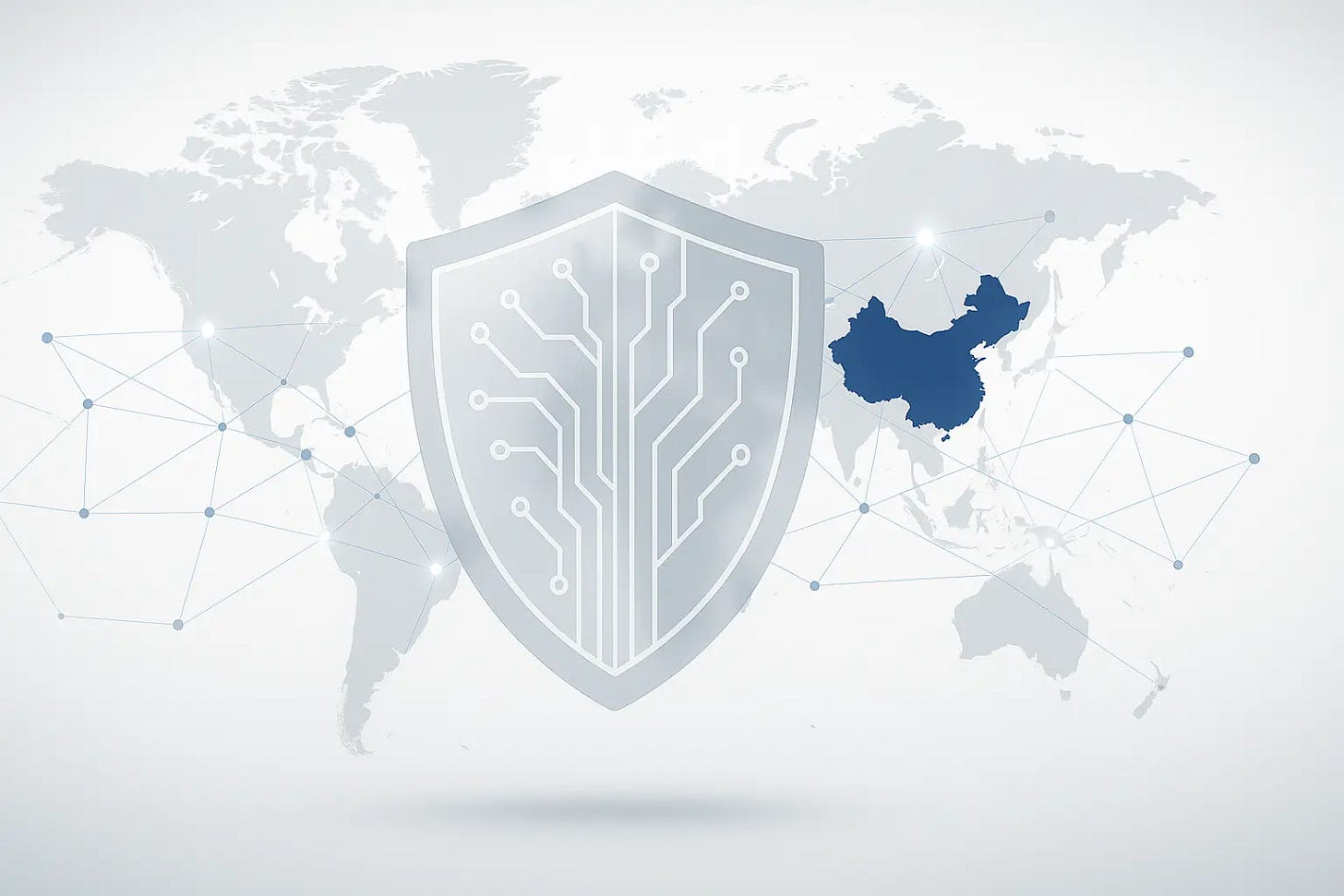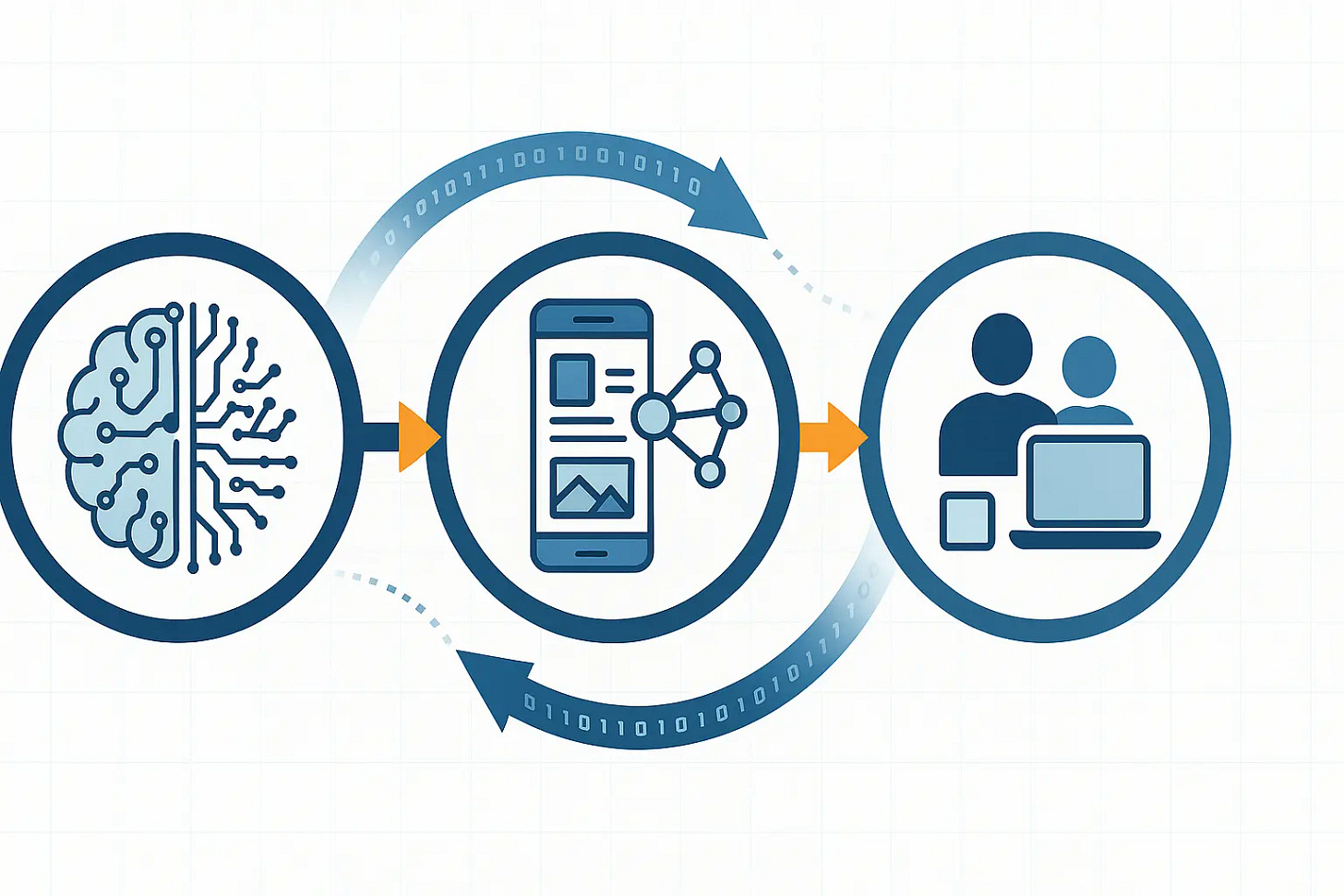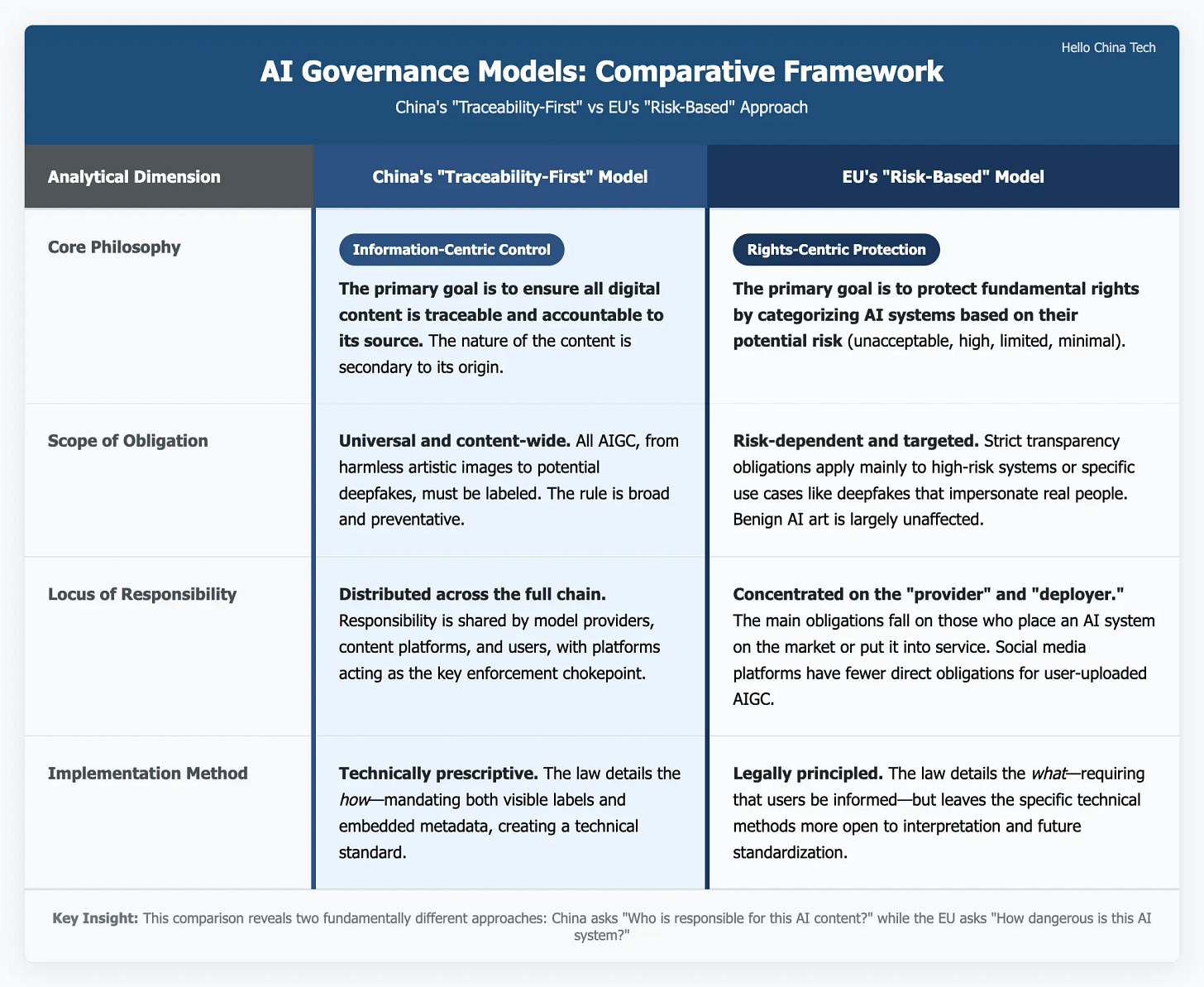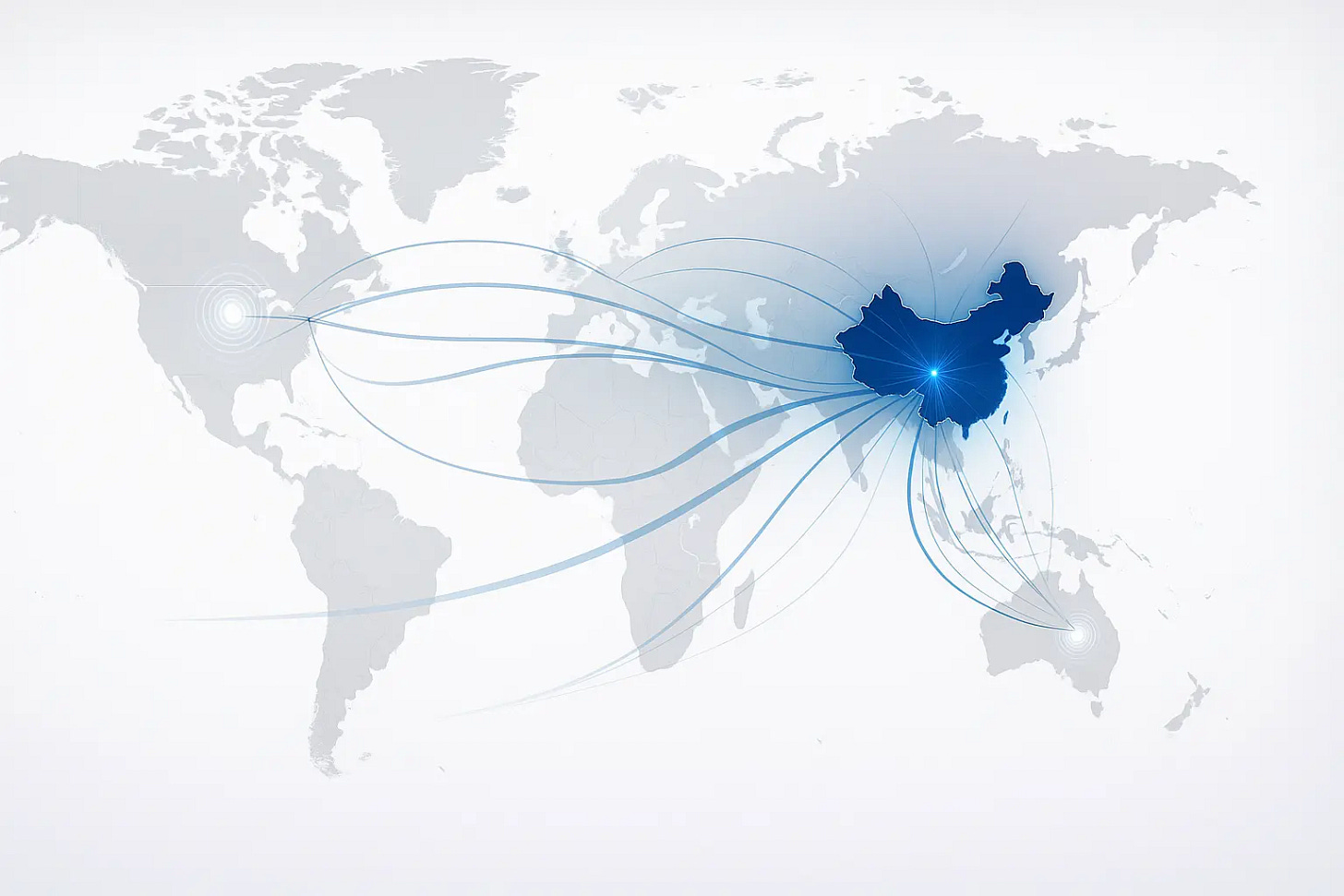China Sets a New Global Standard: The World’s First Comprehensive AI Content Labeling Law
How Beijing’s “watermark mandate” creates a potential template for digital governance—and what it means for global tech companies.
Hello China Tech by Poe Zhao – Weekly insights into China’s tech revolution. I analyze how developments in Chinese AI, electric vehicles, robotics, and semiconductors are reshaping global technology landscapes. Each piece contextualizes China’s innovations within worldwide market dynamics and strategic implications.
As the world grapples with an AI-driven epistemological crisis—where the line between real and synthetic blurs daily—governments from Brussels to Washington are locked in debate over the right regulatory response. Amidst this global deliberation, China has moved with decisive force. On September 1, 2025, its Identification Methods for AI-Generated Synthetic Content came into full effect, mandating that every piece of AI-generated content (AIGC) be explicitly and implicitly “watermarked.”
This move is far more than a simple labeling rule. It represents the world’s first comprehensive, nationwide implementation of a technical and legal framework for AI content traceability. While international observers often focus on the immediate implications for content creators and platforms, to do so is to miss the forest for the trees. The real significance of this “watermark mandate” lies in the underlying governance philosophy it reveals and the analytical framework it provides for understanding China’s approach to regulating emerging technology.
This is not a story about censorship, but about a fundamentally different answer to a universal question: in an age of artificial reality, how do we re-establish accountability and trust? China’s answer is not a philosophical appeal to ethics, but an engineering solution rooted in total traceability. This article will deconstruct the framework behind this policy, contrast it with Western models, and offer a durable lens for observing its long-term impact on both the domestic tech ecosystem and the future of global digital governance.
Beyond the Label: Deconstructing China’s ‘Full-Chain Responsibility’ Framework
To understand the regulation’s power, we must look beyond the visible “AI Generated” tag on an image. The policy’s core innovation is the establishment of a “full-chain responsibility” framework, an interlocking system of obligations that binds every actor in the digital content supply chain. This is not a new concept in China but an extension of a long-standing governance principle known as 压实平台责任 (yāshí píngtái zérèn), or “Compacting Platform Responsibility,” which has been the bedrock of its internet regulation for over a decade.
This framework distributes accountability across three key nodes:
The Source (AI Service Providers): The regulation begins at the point of creation. Companies providing generative AI models—from tech giants like Tencent and Baidu to smaller startups—are now legally required to build labeling capabilities directly into their products. The mandate is twofold: an explicit label (a visible watermark or audio notice) and an implicit label (irremovable metadata embedded in the file). This technical prerequisite transforms compliance from a user’s choice into a feature of the technology itself. It is a proactive, “compliance-by-design” approach that puts the primary onus on the technology’s creators.
The Conduit (Content Platforms):The second line of defense is the distribution network. Super-apps like WeChat and Douyin, which serve as the primary arenas for public discourse and content consumption, are mandated to act as verification gateways. They must deploy technology to detect both explicit and implicit labels. If content is uploaded without a proper label, the platform is obligated to either add one or take the content down. This effectively turns platforms into deputy enforcers of the state’s regulatory will, aligning their commercial interests (avoiding fines and sanctions) with public policy goals.
The End-User (Content Creators): While the primary legal burden falls on providers and platforms, users are not exempt. The regulations explicitly forbid the malicious removal, tampering, or forging of AI labels. While direct enforcement on millions of individual users is challenging, the platform-level enforcement mechanism makes non-compliance difficult. A creator who consistently tries to circumvent the rules risks having their content suppressed or their account suspended, creating a powerful disincentive.
This three-tiered structure is a deliberate architectural choice. It moves beyond simply punishing bad actors after the fact and instead constructs a system designed to make anonymous, untraceable synthetic content a technical impossibility from the outset.
A Divergent Path: The China Model vs. The EU’s Risk-Based Approach
The “watermark mandate” becomes even clearer when contrasted with the prevailing regulatory philosophy in the West, particularly the European Union’s landmark AI Act. While both seek to mitigate the risks of AI, their foundational approaches reveal a deep divergence in regulatory philosophy.
This comparison provides a crucial analytical tool. China’s model is not merely a stricter version of the EU’s; it is a different species of regulation altogether. The EU asks, “How dangerous is this AI system?” China asks, “Who is responsible for this piece of AI content?” The former leads to a complex taxonomy of risk; the latter leads to a universal system of traceability. Understanding this distinction is key to moving beyond simplistic “authoritarian vs. democratic” narratives and appreciating the unique logic driving China’s approach to digital governance.
A Framework for the Future: Three Tensions to Watch
The implementation of the watermark mandate is not an end point but the beginning of a massive, real-world experiment. Its success and long-term impact are not guaranteed. For tech professionals, policymakers, and global observers, the most productive approach is not to pass premature judgment but to use a forward-looking framework to monitor its evolution. This framework should focus on three central tensions that will define the policy’s future trajectory.
1. The Tension Between Control and Creativity:
The most immediate question is how this regulation will affect China’s vibrant creator economy. Will the mandatory “AI Generated” label create a stigma, devaluing the work of digital artists and content creators? For commercial applications, such as advertising or film production, the aesthetic disruption of a watermark is a significant concern. While the law allows for “no explicit label” versions under certain conditions (often as a paid feature), this could create a divide between professional and amateur creators.
Key Indicators: Monitor user engagement metrics on labeled vs. unlabeled content. Observe how platforms and AI tool providers innovate around “aesthetic compliance.” Will new, less intrusive forms of labeling emerge? Will a market for “authenticated human” content arise in response?
2. The Tension Between Compliance and Circumvention:
A regulation is only as strong as its enforcement. The mandate has already sparked a technological arms race. Users are actively searching for ways to “scrub” metadata and remove visible watermarks. In response, platforms and regulators will need to invest in increasingly sophisticated detection technologies. This cat-and-mouse game is a classic feature of internet governance.
Critical Metrics: Track the emergence and popularity of tools designed to circumvent labeling. Pay attention to the first high-profile enforcement cases against platforms or users, as these will set the precedent for the real-world costs of non-compliance.
3. The Tension Between a National Standard and a Global Norm:
China has not just created a domestic rule; it has established a de facto global standard for any company operating within its digital borders. This creates significant compliance challenges for multinational corporations, which must now navigate divergent regulatory regimes in China, the EU, and the US. More profoundly, it raises the question of whether China’s model could be exported. For developing nations also struggling with misinformation, a turn-key, traceability-focused solution may hold appeal.
Global Signals: Observe how global tech companies adapt their products for the Chinese market. Monitor the discourse around AI governance in other regions, particularly in Southeast Asia, Africa, and Latin America. Does the language of “traceability” and “platform responsibility” begin to feature more prominently in their policy debates?
The Road Ahead
Ultimately, China’s AI watermark mandate is a powerful case study in 21st-century governance. It is an ambitious attempt to reassert order in a chaotic digital information environment through systemic, top-down technological design. Whether it succeeds in building trust without stifling innovation is the central question. But for now, it provides the rest of the world not with a model to be copied, but with a crucial–and very different–blueprint to be studied and understood.
This content labeling mandate represents just one piece of China’s broader AI governance puzzle. Combined with the country’s systematic approach to AI service approvals–which has processed over 800 AI applications through its filing and registration system–it reveals a coherent philosophy: treat regulation as infrastructure, not obstacle. While Silicon Valley pursues market-driven innovation and Brussels emphasizes rights-based compliance, Beijing is constructing a third path that integrates oversight into the technology stack itself.
The implications extend far beyond China’s borders. As global tech companies navigate divergent regulatory regimes–from California’s laissez-faire approach to Europe’s precautionary principles to China’s systematic controls–they face an increasingly fragmented world where AI governance strategies may determine competitive advantage. For developing nations watching this regulatory competition unfold, China’s “turnkey traceability” model offers an alternative to both American market chaos and European regulatory complexity.
The AI-driven epistemological crisis that opened this analysis remains unresolved. But in China’s watermark mandate, we see one society’s definitive answer: when reality becomes uncertain, make accountability absolute. Whether this proves to be prescient governance or technological overreach will depend on how well China balances its desire for control with the innovation requirements of an AI-powered economy.
For global observers, the question isn’t whether to applaud or condemn China’s approach, but whether to understand it. In an era where AI governance models are still being written, China has submitted its first draft–and the world is watching.
About Hello China Tech
I’m Poe Zhao, and I bridge the gap between China’s rapidly evolving tech ecosystem and the global community. Through Hello China Tech, I provide twice-weekly analysis that goes beyond headlines to examine the strategic implications of China’s technological advancement.
Found this useful?
→ Share this newsletter with colleagues who need to understand China’s tech impact
→ Subscribe for free to receive every analysis:
→ Follow the conversation on 𝕏 for daily updates and additional insights
Get in touch: Have questions about China’s tech sector or suggestions for future analysis? Reply to this email – I read every message.







